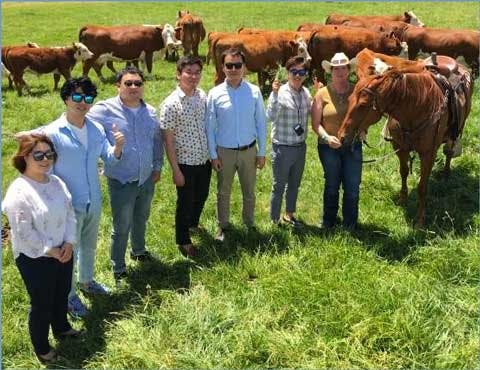Korean e-Commerce Buyer Team Learns about U.S. Red Meat Safety, Quality
USMEF hosted representatives from key Korean e-commerce companies to educate them on the safety and versatility of U.S. red meat, as well as to help them better understand the U.S. “Farm to Table” concept. The team received meat training at the University of Wisconsin, toured a sausage plant and spent time on a Colorado cattle ranch on a trip funded by the USDA Market Access Program (MAP), the Pork Checkoff and the Beef Checkoff Program.

Members of the Korean e-commerce buyer team visit Coyote Ridge Ranch in La Salle, Colorado, on a tour of the U.S. red meat industry
For the U.S. red meat industry, having the team experience the steps required to produce quality meat products is invaluable, according to Jihae Yang, USMEF director in South Korea.
“E-commerce is growing rapidly in Korea and as more Koreans order groceries with their mobile devices, multiple e-commerce platforms are competing to release their own fresh food brands on their websites,” explained Yang. “However, e-commerce sales of products like U.S. meat are in an early stage, as most e-commerce platforms – including TV shopping networks – have been reluctant to aggressively feature U.S. meat. But U.S. products have recently begun to penetrate the e-commerce sector with more competitive pricing, and the interest in U.S. meat is growing significantly.”

At Johnsonville Sausage, the team sees how the plant uses quality U.S. pork raw material in its products
The group’s first stop in the U.S. was for an educational program conducted at the University of Wisconsin. Faculty members Jeff Sindelar and Andy Milkowski lectured on basic meat science, freezing and defrosting, and discussed trends in U.S. meat processing.
A subsequent visit to a Johnsonville sausage plant was a good opportunity to highlight not only U.S. processed pork items – which are gaining popularity in the Korean market – but also the superior quality and safety of U.S. pork as a raw material.

The team attended an educational meat training session at the University of Wisconsin
“Because Johnsonville Sausage has been so successful in the Korean e-commerce sector, participants were curious how U.S. processed pork items are produced, and they were pleased with what they saw,” said Yang. “For example, one member of the team, Sangok Lee, a fresh food merchandiser who has visited pork processing plants in Korea, said he was very impressed with the quality of U.S. meat used in processed products.”
Later, the group traveled to Colorado, where it visited USMEF headquarters in Denver. Team members were given an overview of the U.S. red meat industry by USMEF Director of Market Access and Export Services Travis Arp. Jessica Spreitzer, USMEF trade analyst, presented an update on U.S. red meat production, including export trade statistics and forecasts.

At USMEF headquarters, the team was presented an overview of the U.S. red meat industry, along with an update on production and exports
As a way to further emphasize the “Farm to Table” concept, USMEF took the team to Coyote Ridge Ranch in La Salle, Colorado. The ranch staff emphasized how U.S cattle are raised in a clean, safe and natural feeding environment.
“Importantly, team members learned that U.S. red meat is produced by family farms using traditional farming methods,” said Yang. “Seeing this in person was very valuable, and it really helped the group understand where the U.S. meat they sell to Korean consumers comes from.”
